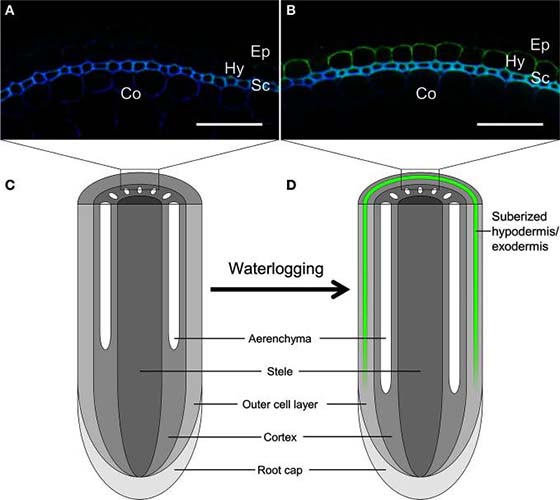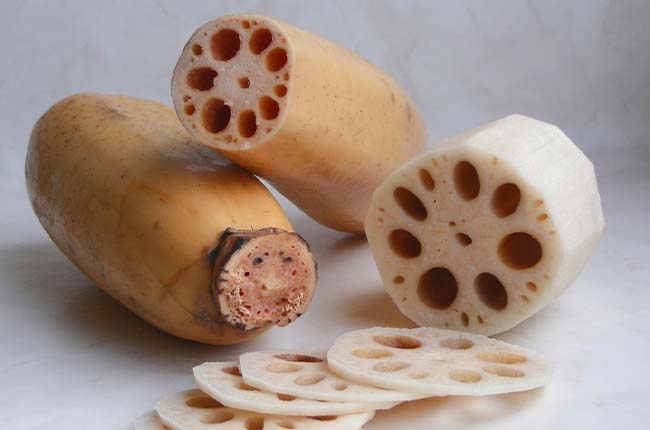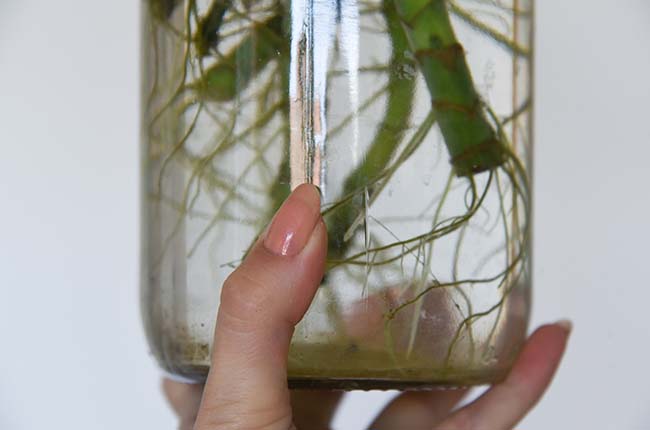If you have ever overwatered your houseplants, you must have noticed that their leaves would turn yellow and their roots would rot with too much water in the soil. However, if you propagate the cuttings in water, they would grow new roots.
How come plants die in waterlogged soil, but can grow in water?
In normally aerated soil, plants grow “soil roots” to absorb water and oxygen from the soil. When the roots are put in water or waterlogged soil, the soil roots will rot due to a lack of oxygen and will be replaced by “water roots” that have special mechanisms to breathe through the leaves and block oxygen loss.
This article will show you the differences between soil roots and water roots, and the special mechanisms water roots have to adapt to a low-oxygen environment.
Let’s get started.
1. Oxygen stress in waterlogged soil
In regular soil, there are air-filled pores in between soil particles.
When the soil is waterlogged or saturated with water, the pores are filled with water molecules instead of air, thus creating a low or no-oxygen environment for soil roots.
When plant roots are submerged in water or waterlogged soil or even when there is a film of water on roots, “soil roots” will die off and will be replaced by “water roots”.
2. Water roots vs. soil roots
Water roots have two special features that allow them to survive in a low- or no-oxygen environment.
2.1 Aerenchyma
Water roots have extensive aerenchyma plant tissues to enable the roots to continue to breathe through the leaves in a low-oxygen or waterlogged environment.
The cells in the root area need oxygen to survive. When plant roots are put under water or in waterlogged soil, the soil root cells cannot receive enough oxygen from the surroundings and will rot and die off. The hormone ethylene is then released and triggers the formation of aerenchyma in the new roots (water roots).
Aerenchyma is hollow air channels inside a root that connects to the stems and leaves, allowing the root cells to continue getting oxygen from the shoots above water. Water roots have extensive aerenchyma structures.
Because of the hollow structure of aerenchyma filled with gas, water roots are thicker with a bigger diameter, more spongy, more brittle, and easier to break than soil roots. Apart from that, water roots also look more white and elongated than soil roots.
Depending on the plant species, most soil roots also have aerenchyma but at a much lower density than water roots, and would thus die in a low-oxygen environment because of suffocation.
2.2 Waxy root coating
Another special feature water roots have to adapt to a low-oxygen environment is to develop a wax coating on the water roots.
This coating is made of a waxy substance called “suberin” which acts as a barrier that prevents the entry and loss of oxygen, water, salts, and toxic compounds into and from the roots (Watanabe et al., 2013).
The more difficult the environment (e.g. low oxygen, high salinity, a high number of pathogens), the more this waxy coating covers the whole length of a root, except the root tip.
In contrast, soil roots do not have such a waxy barrier to the surrounding. With a pore size of 3.5 to 5.2 nm in diameter (Capita et al., 1979), water, oxygen, and salts can move in and out freely, causing soil roots to rot and die under a low-oxygen environment.
Also, since pathogens can freely enter porous soil roots, that explains why soil roots are more susceptible to pathogen attack and rot in a waterlogged environment.

3. More pathogens in the soil
Another reason why soil roots rot in waterlogged soil is that there are more pathogens in soil than in water.
Many soil-borne pathogens including fungi (e.g. Pythium, Phytophthora) and bacteria (e.g. Oomycetes, Rhizoctonia solani) can survive in the soil even after the use of the herbicide.
Also, when we grow plants in a water culture, we tend to use change the water much more often than change the soil and the tap water we use most likely contains chlorine.
4. Oxygen level in water vs soil
The concentration of oxygen in water is higher than in soil that is saturated with water.
Water culture generally contains more oxygen than waterlogged soil because it is often changed from time to time.
Also, oxygen moves about 10,000 times slower in water than it is in the air but moves much more slowly (320,000 times less than in air) when the soil pores are filled with water (Armstrong & Drew, 2002).
Also, there is a high population of microorganisms in the soil that compete for oxygen, quickly turning the wet soil anaerobic which can easily suffocate soil roots.
5. Examples of plants with water roots
Not all terrestrial plants (or dryland plants) can develop water roots with extensive aerenchyma to adapt to a low-oxygen environment. Different species have different tolerance levels to waterlogging or oxygen stress.
Wetland species such as rice, maize, and lotus, are capable of growing water roots with the most developed aerenchyma that are always present. Their roots have large air channels and are capable of tolerating long periods of flooding.
An example of roots with a high density of aerenchyma is the roots of a lotus, a wetland plant with roots completely submerged in mud and water and with leaves extended above water.

FotoosRobin, CC BY-SA 2.0, via Wikimedia Commons
Many dryland species (e.g. wheat, maize) and those with ancestors living in wetlands (e.g. aroids) can also replace their soil roots with water roots during waterlogging.
But, the ability of dryland species to adapt varies with the extent of aerenchyma plant tissues they can produce in their water roots under waterlogging conditions.
As shown in a study (Baruch & Mérida, 1995), the German grass (Echinochloa polystachya), a wetland species, adapt to the waterlogging environment with 45.7% aerenchyma tissues covering its root area.
The Giant thatching grass (Hyparrhenia rufa), a dryland species native to Africa, is even more capable of adapting to waterlogging by growing extensive aerenchyma plant tissues, covering 51% of the area of its roots, under flooded conditions.
In contrast, another dryland species, Gamba grass (Andropogon gayanus), was found to be the least capable of adapting to waterlogging by growing the least aerenchyma plant tissues, covering only 25% of its root area under waterlogging conditions.
| Plant species | Root area with aerenchyma under waterlogging |
| German grass (wetland species) | 45.7% |
| Giant thatching grass (dryland species) | 51% |
| Gamba grass (dryland species) | 25% |
Conclusion
When a terrestrial plant is overwatered and is under oxygen deficiency for a period of time, its soil roots would rot and die off. The soil roots would have to be replaced by water roots with aerenchyma tissues to breathe through the leaves, and a waxy barrier to prevent oxygen loss from the roots.
However, not all terrestrial (dryland) plants can grow water roots to adapt to a low- or no-oxygen environment. And different species have different tolerance levels.
To learn how to convert water roots to soil roots, read this next article.
Happy gardening!
Related
Convert Water Roots to Soil Roots: Step-by-Step Guide
Fuzzy Roots: Root Hair or Mold? (How to Identify)
References
APS Publications (2018, July). Succession of Fungal and Oomycete Communities in Glyphosate-Killed Wheat Roots.
Baruch, Z. & Mérida, T. (1995). Effects of Drought and Flooding on Root Anatomy in Four Tropical Forage Grasses. International Journal of Plant Sciences. Vol. 156 (4), pp. 514-521.
Evans, D. E. (2003). Aerenchyma formation. New Phytologist.
Michigan State University. Plant & Pest Diagnostics. Phytophthora root and stem rot.
New Pathology Foundation (n.d.). Aerenchyma formation.
Watanabe, K., Nishiuchi, S., Kulichikhin, K. & Nakazono, M. (2013). Does suberin accumulation in plant roots contribute to waterlogging tolerance? Frontiers in Plant Science, 4: 178.
Wisconsin Horticulture. Division of Extension (n.d.). Pothos, Epipremmum aureum.
Yamauchi, T., Colmer, T. D., Pedersen, O. & Nakazono, M. (2018). Regulation of Root Traits for Internal Aeration and Tolerance to Soil Waterlogging-Flooding Stress. Plant Physiology, Vol 176 (2), pp. 1118–1130.
- Top 6 Drip Irrigation Systems for Raised Beds (2025) - January 31, 2025
- Top 10 Orchid Fertilizers: A Comprehensive Review (2025) - January 16, 2025
- Top 6 Slow-Release Fertilizers for Houseplants & Veggies (2025) - January 15, 2025

